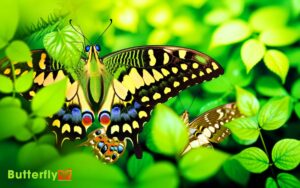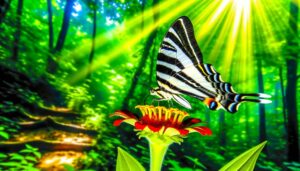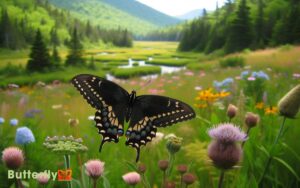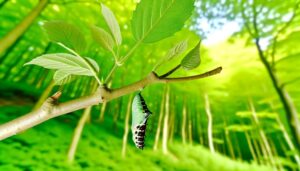Dainty Swallowtail Butterfly Life Cycle: Explore!
The Dainty Swallowtail Butterfly‘s life cycle begins with the female laying spherical eggs, 1-2 mm in diameter, on host plants like citrus.
The embryogenesis phase lasts 4-10 days before the first instar larva emerges, ready to feed on foliage. The larval stage involves rapid growth through various instars, accumulating essential nutrients for metamorphosis.
The caterpillar then forms a chrysalis for the pupal stage, where significant physiological changes occur.
An adult butterfly with a 70-100 mm wingspan emerges, focusing on reproduction during its 10-12 day lifespan. Understanding each stage reveals the intricate processes driving their survival.
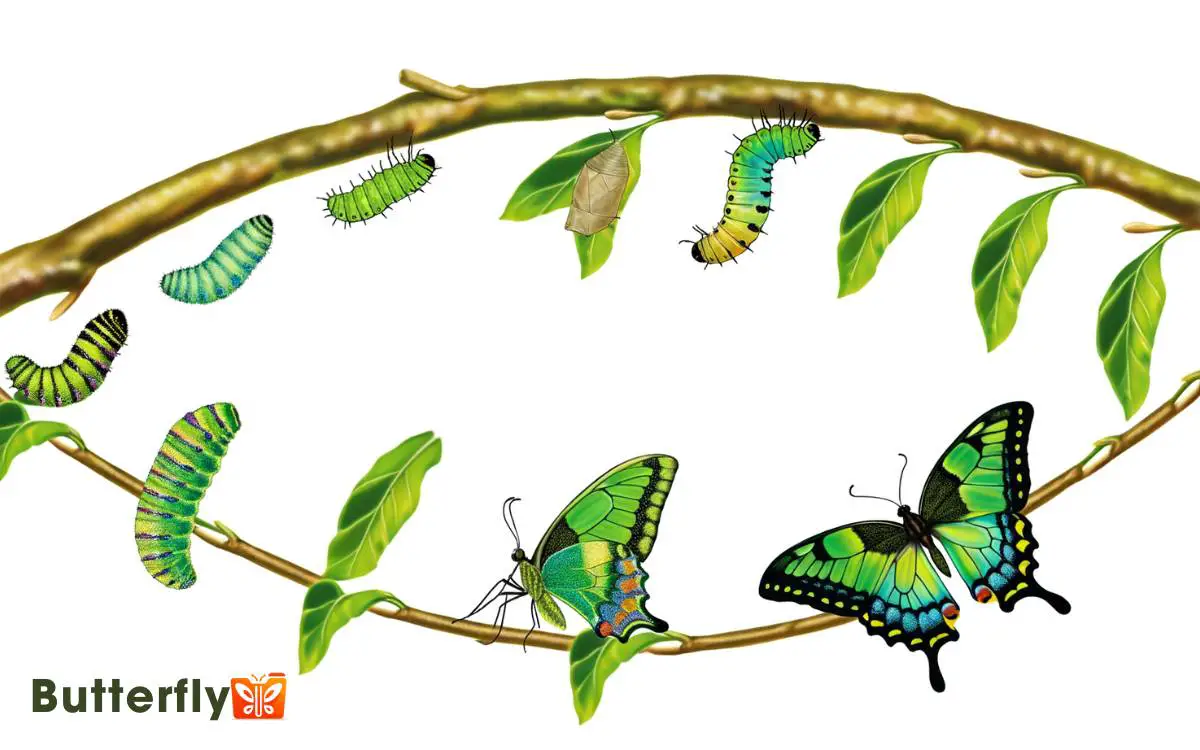
Key Takeaways
Egg Stage
The egg stage of the Swallowtail Butterfly begins when the female lays her fertilized eggs on the leaves of host plants, ensuring the larvae will have an immediate food source upon hatching.
These eggs are typically spherical, measuring about 1-2 millimeters in diameter, and possess a smooth or slightly ribbed surface. They exhibit a pale yellow or green hue, camouflaging effectively against foliage.
The female strategically selects specific host plants, such as parsley, fennel, or citrus, to optimize larval survival rates. Embryogenesis within the egg lasts approximately 4-10 days, depending on environmental conditions like temperature and humidity.
During this period, cellular differentiation and tissue formation occur, culminating in the emergence of a first instar larva, ready to start its next developmental phase.
Larval Stage
Upon hatching, the first instar larva emerges, equipped with specialized mouthparts designed for consuming the host plant’s foliage. This stage is characterized by rapid growth through a series of molts, known as instars.
Each instar sees the larva increase in size and develop more complex features, such as thoracic legs and prolegs, which enhance mobility.
The larval stage is crucial for nutrient accumulation, as the caterpillar consumes vast amounts of leaves to prepare for metamorphosis.
| Instar | Key Features | Duration (Days) |
|---|---|---|
| 1st | Simple body structure, small size | 2-3 |
| 2nd | Slightly larger, new setae | 3-4 |
| 3rd | Noticeable color changes | 4-5 |
| 4th | Increased appetite | 5-6 |
| 5th | Fully developed, large size | 6-7 |
Pupal Stage
During the pupal stage, the swallowtail caterpillar forms a chrysalis by secreting silk to create a support structure.
This stage, known as metamorphosis, involves extensive physiological changes that are orchestrated at the cellular level.
The duration of this transformation varies, typically ranging from a few weeks to several months, depending on environmental conditions.
Chrysalis Formation Process
How does the caterpillar change into a chrysalis?
The process begins when the caterpillar finds a suitable location, often a branch or leaf. It attaches itself using silk and gradually sheds its final larval skin, revealing the chrysalis underneath.
This transformation is critical for successful pupation, allowing the organism to reorganize its internal structures.
- Silk Pad Creation: The caterpillar spins a silk pad to secure itself.
- Molt Initiation: It undergoes one last molt, shedding its outer skin.
- Chrysalis Emergence: The chrysalis becomes visible as the skin is shed.
- Secure Attachment: The chrysalis attaches firmly to the substrate with a cremaster hook.
This stage is pivotal, ensuring the caterpillar’s safe shift into the next phase of metamorphosis.
Metamorphosis Duration Insights
The pupal stage of the swallowtail butterfly, known as metamorphosis, typically lasts between 10 to 20 days, depending on environmental factors such as temperature and humidity.
During this period, the chrysalis undergoes significant physiological changes. Enzymes break down larval structures, while imaginal discs develop into adult features wings, antennae, and legs.
Cooler temperatures can prolong the pupal stage, while warmer conditions accelerate it. Humidity levels also play a critical role, as too much moisture can lead to fungal infections, while too little can cause desiccation.
The pupal stage is a vulnerable yet transformative phase, showcasing nature’s ingenuity in adapting to varying climates.
This intricate balance guarantees that the butterfly emerges fully formed and ready for its first flight into freedom.
Adult Butterfly
Once metamorphosis is complete, the swallowtail butterfly emerges from its chrysalis with fully formed wings and reproductive organs. This stage is marked by several key characteristics and behaviors crucial for survival and reproduction. The newly emerged butterfly takes time to expand and dry its wings before its first flight. During this period, it gains strength and prepares to search for nectar and potential mates. The process of Chinese yellow swallowtail metamorphosis highlights the intricate transformation required for the butterfly to thrive in its natural habitat.
The adult butterfly engages in flight to search for mates and suitable oviposition sites. Its wings, adorned with intricate patterns, provide both camouflage and warning signals.
- Wingspan: Ranges from 70 to 100 mm, facilitating efficient flight.
- Lifespan: Typically lasts 10 to 12 days, focusing on reproduction.
- Reproductive system: Males have claspers for mating, while females possess an ovipositor for egg-laying.
- Sensory organs: Compound eyes for wide field vision, antennae for detecting pheromones.
These features guarantee the adult butterfly can fulfill its ecological roles effectively.
Habitat and Diet
As the adult swallowtail butterfly navigates its environment, it relies on specific habitats and dietary needs to sustain its short lifespan.
Preferring temperate regions, these butterflies thrive in gardens, woodlands, and meadows where they access nectar from a variety of flowering plants.
Their diet primarily consists of nectar sourced from flowers such as lantana, lilac, and milkweed. The availability of host plants is essential for laying eggs, ensuring the survival of the next generation.
| Habitat | Dietary Source | Specific Plants |
|---|---|---|
| Gardens | Nectar | Lantana, Lilac |
| Woodlands | Nectar | Milkweed, Thistles |
| Meadows | Nectar | Clover, Sunflowers |
Such precise habitat and diet preferences highlight the delicate balance required for their survival.
Conservation Efforts
Conservationists employ targeted strategies to preserve swallowtail butterfly populations, focusing on habitat restoration, pollution control, and the protection of native plant species. They guarantee larval host plants and nectar sources are abundant and accessible.
Pollution control measures reduce pesticide and herbicide use, minimizing harm to butterflies and their habitats. Protecting native plant species prevents the loss of essential resources for caterpillars and adult butterflies alike.
- Habitat Restoration: Reestablishing native vegetation and ecological balance.
- Pollution Control: Implementing regulations on chemical usage to safeguard ecosystems.
- Plant Protection: Conserving and propagating key flora species.
- Community Engagement: Educating and involving local communities in conservation practices.
These multifaceted efforts aim to maintain and enhance swallowtail butterfly survival and proliferation.
Conclusion
To wrap up, the dainty swallowtail butterfly‘s life cycle from egg, through larval and pupal stages, to adult illustrates nature’s intricate design. Each stage is vital for survival and reproduction.
Their habitats, often threatened by human activity, require conservation efforts to maintain balance.
What can be more fascinating than witnessing this delicate transformation firsthand? By understanding and protecting these butterflies, we guarantee the continuity of their species and the ecosystems they enrich.

